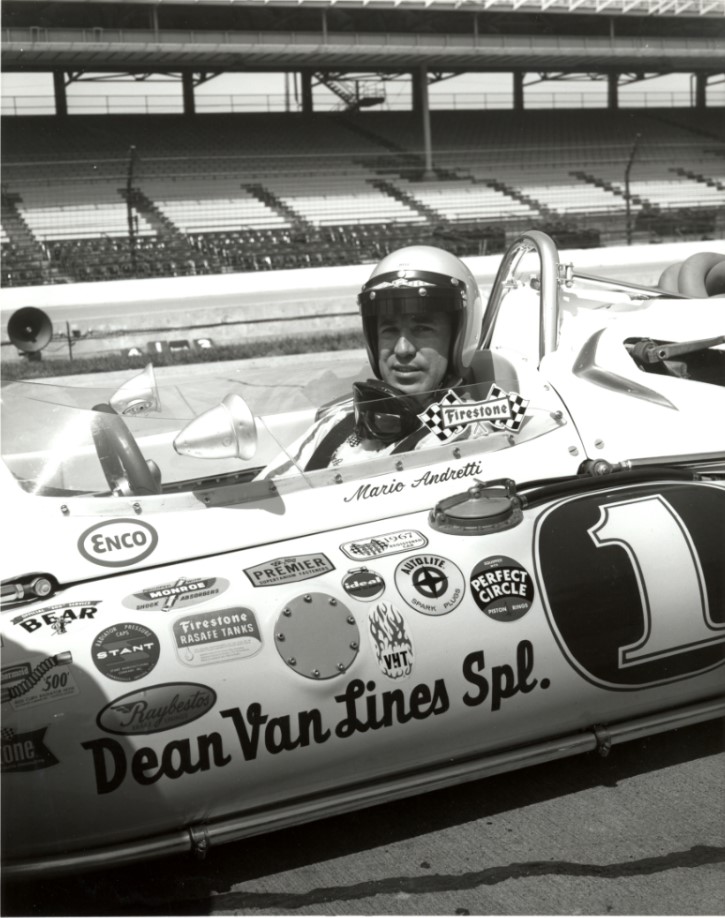|

At home in Watkins Glen 1978. Already crowned World Champion, he was the center of attention before over 100,000 fans, having won the pole by over 1 second.
|

Trenton April 30, 1977. The signature Andretti profile. Mario signed this photograph, and the adjacent one, for me the following year at Watkins Glen.
|
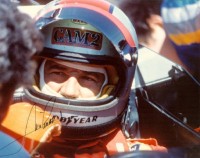
Trenton April 30, 1977. Mario discusses car setup. Mario drove only a handful of Indy Car races between 1976 and 1982, while he drove in F-1
|
|

Indy Pole 1966 w/Clint Brawner, Al Dean & Jim McGee. Some say Juan Montoya is great, having won the CART championship in his rookie year. In this 1966 photo, Mario's car wears #1, signifying he was the 1965 champion, a feat he too accomplished in his rookie year. In fact Mario went on to repeat as champion in 1966, lost by a few points in 1967 and 1968, and then won the championship again in 1969. If he had not lost by those slim margins in 67 and 68, he would have won the championship 5 straight years.
|
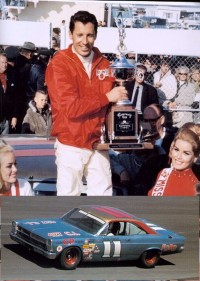
Victory Lane 1967 Daytona 500. Mario outran NASCAR Goldenboy and Holman and Moody Ford teammate, Freddie Lorenzen, to become the first non-NASCAR driver to win the Daytona 500. Running the car loose all day, he ran the race's fastest laps
|

How good was he? Mario takes pole in his very 1st F-1 race, Watkins Glen, NY 1968. In the race he dropped out with a broken clutch, but not before standing the F-1 establishment on its ear
|
|
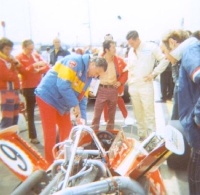
Mario & Bobby Unser discuss his radical 'dihedral (v wings)' Vel's Parnelli car at Trenton in April 1972
|
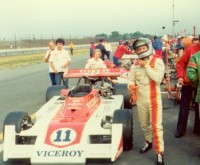
Trenton April 1973. Mario steps out of his #11 Viceroy machine. Mario was part of the 'Super Team' of Andretti, Al Unser, and Joe Leonard.
|
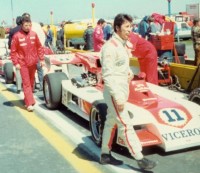
Trenton April 1973. The Vel-Parnelli chassis was no match for Dan Gurney's Eagles back then and 1973 was a lackluster year for Mario.
|
|
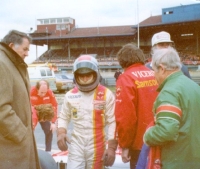
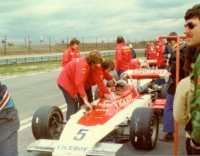
Trenton 1974. A cold gray day in central New Jersey. Mario had a lot of success at Trenton, winning on both the 1-mile oval and then again when it was lengthened to 1.5-miles, nine times in total. He won the first race at Trenton when it was lengthened to 1.5 miles in 1969, and won the last race ever run at Trenton driving for Roger Penske in 1979. For me, Trenton is where I caught the auto racing bug in 1965.
|



STP sponsored Mario in 1969 and 1970. Top – Mario piloted the STP Brawner-Hawk to a win at Indy in 69. Below, in the Colin Chapman designed Lotus he dominated with throughout practice. However, two days before qualifying was to begin the car broke a right rear wheel hub sending Mario hard into the wall and to the hospital with burns on his face. The team brought out the backup Brawner-Hawk and the rest is history.
Headlines from Competition Press & Autoweek. Photos by M. Cipolloni
|




Top, 1971 driving the Ferrari 312 B2, the same car that carried him to his first F-1 win earlier in the year in South Africa on March 6, 1971 (Bottom). Three weeks later it also carried him to two wins in the non-points paying Questor GP at the former Ontario Motor Speedway.
Headlines from Competition Press & Autoweek. Photo by M. Cipolloni
|
|

Mario's win in the 3/28/71 Questor GP at Ontario Motor Speedway was very popular. Competition Press & Autoweek ran this headlines. Three weeks later it also carried him to two wins in the non-points paying Questor GP at the former Ontario Motor Speedway where he beat Jackie Stewart in both heats. In the first heat Mario passed Stewart on the final lap to take the win. In the second heat, Stewart got the jump on Mario at the start and led the first 7 or 8 laps. Mario then passed and pulled away for a dominating win. That race was dubbed the war of the worlds, pitting Americans in F-5000 machines against the F-1 cars and stars. As expected the F-1 cars dominated that day, but the American fans had something to celebrate, Mario was American.
|
 After driving F-1 occasionally for Lotus in the late 60's and occasionally for Ferrari in the early 70's, Mario raced the following years in the USA honing his road racing skills in F-5000. Mario was always the fastest driver on the F-5000 circuit in this Viceroy Chevrolet powered Lola, completely dominating qualifying and every race for two years. However, Brian Redman, driving for the Carl Haas team won the championship both years Mario drove in F-5000 by consistently finishing races. Mario's car often broke. He has stated that those years helped prep him for his onslaught on the F-1 world title in 1974 After driving F-1 occasionally for Lotus in the late 60's and occasionally for Ferrari in the early 70's, Mario raced the following years in the USA honing his road racing skills in F-5000. Mario was always the fastest driver on the F-5000 circuit in this Viceroy Chevrolet powered Lola, completely dominating qualifying and every race for two years. However, Brian Redman, driving for the Carl Haas team won the championship both years Mario drove in F-5000 by consistently finishing races. Mario's car often broke. He has stated that those years helped prep him for his onslaught on the F-1 world title in 1974
|
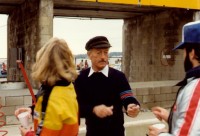
Colin Chapman, the mastermind behind the Lotus empire for which Mario won 11 of his 12 F-1 wins, shown here signing autographs at Watkins Glen in 1979. When the Vels-Parnelli F-1 team fell apart after an unsuccessful 1975 season, Mario found himself without a F-1 ride again. It just so happened that Colin Chapman needed a driver and in 1976 they were reunited. Mario won the last race of 76 in a downpour in Japan. In 1977 Chapman and Andretti won the most races and the most poles, but Mario finished 3rd in the World Championship due to a multitude of engine failures. In 1978 they repeated that domination with the Lotus 79 and won the world championship.
|
|

Winning in Argentina in early 1978. His 1st step toward the F-1 title. In that race he used the same car that carried him to four wins in 1977, the Lotus 78, the first real ground-effects car. Although he won more races than anyone else in 1977, and more pole positions (sometimes by as much as 1.5 sec), he finished third in the championship. Colin Chapman believed in pushing the envelope, and the Lotus team was the beneficiary of the development Ford Cosworth that year. Unfortunately for Mario and the team, it blew up regularly.
|
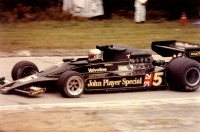


Above, in the successful Lotus 78 on the Andretti Straight at Mosport, Canada, October 1977. Center, in the first race in the Lotus 79, Mario wins wire-to-wire in the '78 Belgium GP. Below, defending F-1 champion, James Hunt gets the jump on Mario in the '78 Spanish GP. Not for long though as Mario passed him on lap 5 and disappeared into the distance to claim his 2nd win of 1978, winning easily over his teammate Ronnie Peterson.
|
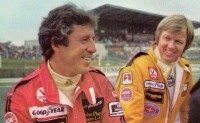
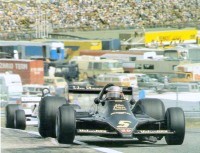
Above, Mario and his teammate, the late Ronnie Peterson. Mario and Ronnie developed a close relationship in 1978. Below, Mario gets airborne over the curbs en-route to victory in Jarama, Spain 1978. Andretti and Peterson would finish 1-2 in five races that year, Belgium, Spain, France, Germany and Holland. Andretti was able to out qualify Peterson in all but a couple of races that year, but on race day, Peterson usually gave Andretti a run for his money. In the end Andretti won six races that year and with it the F-1 crown.
|
|
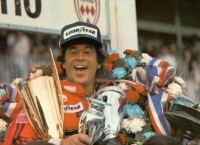
Enjoying the fruits of victory in the 78 French GP. After starting 2nd, he took the lead on the first lap and led flag-to-flag with teammate Ronnie Peterson in 2nd.
|
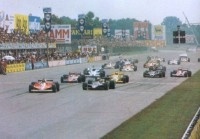
Gilles Villeneuve gets the jump on Mario at the Italian GP, the race where Mario would clinch the title and his teammate, Ronnie Peterson, would lose his life.
|

The beautiful Lotus 79 which took Mario to the World Championship in 1978, only the 2nd American to ever do so.
|
|
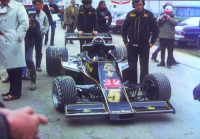
Watkins Glen 1976. Mario's Lotus in the paddock.
|

Watkins Glen 1976, Mario heads for turn 8.
|
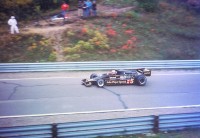
Mosport 1977. Blasting up the Andretti Straight
|
|
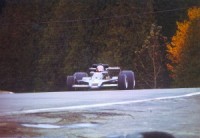
Mosport 1977. Up over the brow of the hill leading onto the long Andretti Straight. Andretti and James Hunt had a stirring battle the entire race, Mario leading Hunt by no more than 1 second. Towards the end James Hunt and his McLaren teammate crashed out of the race leaving Mario to cruise home to the victory. However, with a lap on the field and just taking it easy, his motor blew several laps from the end.
|

Above, leading the field at the start in Kyalami, South Africa 1978 in the Lotus 78. The team did not switch to the Lotus 79 until the Belgian GP that year. His teammate, Ronnie Peterson won when Mario ran out of fuel two laps from the end.
|

Billboards like this one were prominent at the Glen in 78
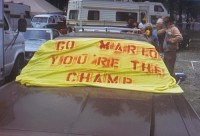
Even the fans got into the act.
|
|

Watkins Glen 1978, braking hard for turn 7.
|

Watkins Glen 1978. The World Champion accelerates hard out of turn 11 in his Lotus 79.
|

Montreal 1978. Already crowned World Champion
|
|
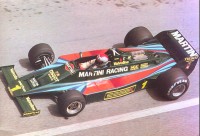
Above, 1979 at Monaco in the unsuccessful Lotus 80. The longer wheelbase car did not perform as well as the Lotus 78 and 79. Mario tried to defend his F-1 title in the dark green Martini and Rossi Lotus 80 but it was so unsuccessful the team switched back to the year old Lotus 79 half way through the 79 season. Gone were the traditional black with gold pinstripes of longtime Lotus sponsor Players cigarettes.
|
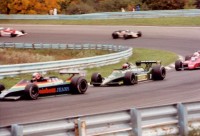

Both photos were taken at Watkins Glen in October of that year in turn 7 of the 'boot' section of the track, a section not currently used by NASCAR. For a map of the circuit, click here.
|
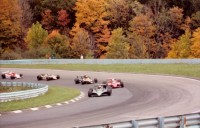
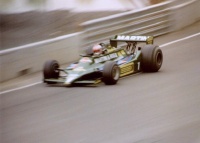
Above, Watkins Glen 1979, Mario leads a group of cars. Note the bright autumn colors which would greet the F-1 establishment each October in upstate New York. The bottom photo was taken in Montreal Canada that same year
|
|
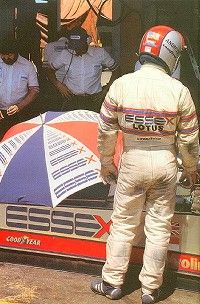
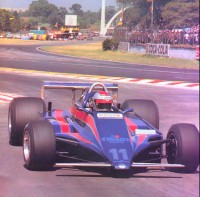
In the Essex sponsored Lotus 81 at the Argentina GP in 1980
|

Talking with Jim McGee in Trenton April 30, 1977. Along with Clint Brawner, the trio enjoyed much success together in the 1960's. Jim has served as crew chief for many drivers over the years, and currently works as Team Manager for the Patrick Racing CART team.
|

Ready to race the CAM2 sponsored Penske in Trenton April 30, 1977
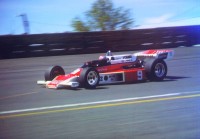
Diving into turn 1 at Trenton. Even though Mario drove F-1 full-time in 1977, he still found time to run a few Indy car races for Roger Penske.
|
|

In 1981, F-1 refused to race at Watkins Glen for safety reasons and moved the race to Las Vegas. CART took over and here Mario is shown getting into his Pat Patrick Wildcat on a wet day in October.
|
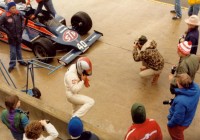
Although he was still driving fulltime in F-1, Mario ran a number of races for Pat Patrick in the early 80's teamed with Gordon Johncock. Here at Watkins Glen he is shown jumping over the wall after exiting his car.
|
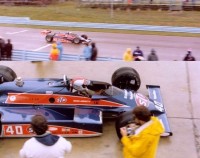
Practice and qualifying at The Glen in 81 were wet and cold, and Mario, with his extensive F-1 road racing experience was on pole. On race day he led effortlessly until the transmission failed.
|
|

At Riverside, CA in 1979, on his way to a win and the IROC crown. More than any other driver, Mario demonstrated that he could win in any type of race car, even 'stock' cars which were not his forte.
|
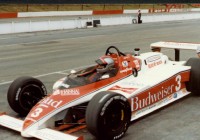
Mario returned to Indy Cars full time in 1983 driving a new Lola for team owners Paul Newman and Carl Haas. He managed to win two races that year in a car that still needed development.
|

After winning the CART championship easily in 1984 (his 4th such title), his car adorned the #1 in 1985. Here he is shown slipping into his Lola at Pocono.
|
|

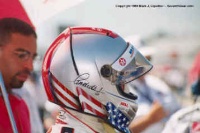
The signature Andretti silver and red helmet design is known the world over. In honor of their father, his sons Michael and Jeff always race with the same helmet design, proudly displaying the American flag in the back.
|
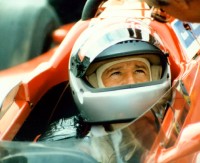
Another photo from the 1985 Pocono 500. Mario only won once at his hometown track, the next year (1986). He and Michael get away from the racing rat race in their nearby Pocono resort.

Photo courtesy Newman Haas Racing
Will he race at LeMans again in 2001?
|

Signing autographs after being inducted into the Italian-American Hall of Fame in 1976 in Atlantic City, New Jersey. Although Mario cherishes his Italian heritage, he always considered himself an American first and foremost.

Watkins Glen 79 – Mario for Pope
|
|
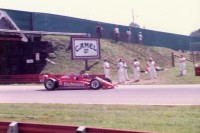
Mid-Ohio 1984. On his way to a dominating flag-to-flag win and another 22 points toward the CART crown.
|

Mid-Ohio in 1986. Photo taken from pit box roof.
|
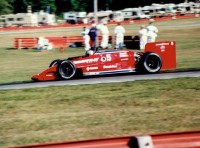
In the carousel at Mid-Ohio in 1986. Note the size of the rear wing end plates back then.
|
|
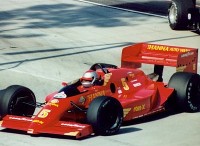
In the hairpin at Long Beach April, 1987. Mario led every lap that day. He was so dominate he won the pole by almost 2 seconds and lapped the entire field once and was a few seconds shy of lapping the entire field twice. It was the first win for the Ilmor Chevrolet engine that was to dominate CART for several years.
|

Long Beach 1987 sitting on the pit wall that same year after practice talking to then Lola engineer Adrian Newey. The same Adrian Newey who later went on to design the dominate Williams, McLaren, and Red Bull F-1 cars that won many world championships.
|

With wife Dee Ann at Long Beach in 1988. Dee Ann was often seen in victory lane in Mario's early days as a race driver. However, later she always avoided the limelight and was seldom seen at the track, preferring instead to stay home and raise sons Michael and Jeff, and daughter Barbara on Victory Lane in Nazareth, Pennsylvania.
|
|
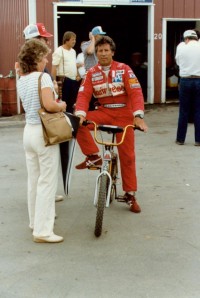
At Pocono in 1983. Mario always tried to find time to chat with friends and fans especially at Pocono (and later at Nazareth) his home track.
|
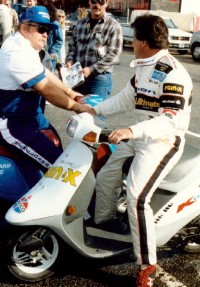
Talking with Ron Hemelgarn at Long Beach in 1988, years before the CART/IRL split. Ron now owns an IRL team while Mario remains firmly planted in the CART camp.
|
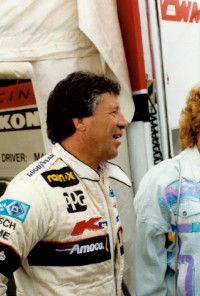
1988 at Cleveland. Mario would go on to out duel Bobby Rahal that day in probably one of his greatest and most satisfying drives, that at the ripe age of 48.
|
|

Mario and his twin brother Aldo at Nazareth 1999. Both follow their sons careers closely, Mario of Michael in CART and Aldo of John in NASCAR
|
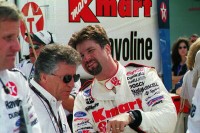

Above photo at Long Beach 1999, one below from Michigan 1999. Michael and Mario still discuss race setups to this day. Mario told us an Andretti CART team will happen eventually. Hopefully sooner rather than later.
|
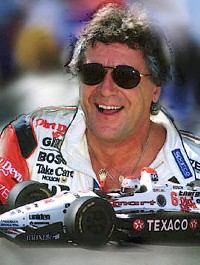
Composite from Mario's last race in Laguna Seca. The culmination of a career that started as a little boy in a displaced persons camp after World War II and grew to become perhaps the greatest driver this world has ever known.
Photo courtesy Steve Giberson
|

